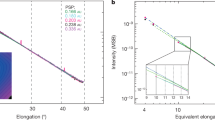Abstract
In the absence of magnetic field measurements of the solar corona, the density structure of white-light images has provided important insight into the coronal magnetic field. Recent work sparked by highly sensitive radio occultation measurements of path-integrated density has elucidated the density structure of unprocessed solar eclipse pictures. This paper does the same for processed images that reveal low-contrast small-scale structures, specifically Koutchmy’s edge-enhanced white-light image of the 11 August 1999 solar eclipse. This processed image provides visual evidence for two important results deduced from radio occultation measurements of small-scale density variations. First, in addition to the closed loops readily seen at the base of the corona in high-resolution EUV and soft X-ray images, open filamentary structures permeate the corona including active regions generally thought to be magnetically closed. Observed at the image resolution, the filamentary structures are 1° wide in latitude and an order of magnitude smaller than polar plumes. Second, although inhomogeneities that are convected along with the solar wind are also present, filamentary structures dominate the image because of their steeper density gradients. The quantitative profile of polarized brightness (pB) at the base of the corona shows that the filamentary structures have transverse density gradients that are proportional to their density. This explains why edge-enhanced images, limited in sensitivity to density gradients, tend to detect filamentary structures more readily in high-density regions (e.g., active regions, streamer stalks, and prominences) than in low-density polar coronal holes, and why filamentary structures seem more prevalent in solar eclipse pictures during solar maximum. The pB profile at the base of the corona also fills the gap in Doppler measurements there, reinforcing that open ultra-fine-scale filamentary structures observed by the radio measurements are predominantly radial and that they are an integral part of the radial expansion of the solar wind.
Similar content being viewed by others
References
Abramenko, V., Yurchyshyn, V., Wang, H., Goode, P.R.: 2001, Solar Phys. 201, 225.
Aschwanden, M.J.: 2004, Physics of the Solar Corona, Praxis, Chichester.
Bougeret, J.L., Steinberg, J.L.: 1977, Astron. Astrophys. 61, 777.
Bourgois, G.: 1969, Astron. Astrophys. 2, 209.
DeForest, C.E., Lamy, P.L., Llebaria, A.: 2001, Astrophys. J. 560, 490.
Dennison, P.A., Hewish, A.: 1967, Nature 213, 343.
Eddy, J.A., Lee, R.H., Emerson, J.D.: 1973, Solar Phys. 30, 351.
Erickson, W.C.: 1964, Astrophys. J. 139, 1290.
Fisher, R.R., Guhathakurta, M.: 1995, Astrophys. J. 447, L139.
Golub, L., Pasachoff, J.: 1997, The Solar Corona, Cambridge University Press, Cambridge, 202.
Grall, R., et al.: 1996, Nature 379, 429.
Guhathakurta, M., Fisher, R.R.: 1995, Geophys. Res. Lett. 22, 1841.
Habbal, S.R.: 1994, Space Sci. Rev. 70, 37.
Habbal, S.R., Woo, R., Arnaud, J.: 2001, Astrophys. J. 558, 852.
Habbal, S.R., et al.: 2001, Obs. Travaux 53, 22.
Hansen, R.T., et al.: 1969, Solar Phys. 7, 417.
Hewish, A.: 1972, In: Sonnett, C.P., Coleman, P.J. Jr., Wilcox, J.M. (eds.) Solar Wind Three, NASA SP 308, NASA, Washington, 477.
Hundhausen, A.J.: 1977, In: Zirker, J.B. (ed.) Coronal Holes and High Speed Streams, Colorado Associated University Press, Boulder, 225.
Koutchmy, O., Koutchmy, S.: 1989, In: von der Lühe, O. (ed.) 10th SPO Workshop Proceedings, NSO, 217.
Koutchmy, S., Bouchard, O., Mouette, J., Koutchmy, O.: 1993, Solar Phys. 148, 169.
Koutchmy, S., et al.: 1992, Astron. Astrophys. Suppl. Ser. 96, 169.
Koutchmy, S., et al.: 2001, Obs. Travaux 53, 35.
Mentzel, D.H.: 1959, Our Sun, Harvard University Press, Cambridge, 189.
Morgan, H., Habbal, S.R., Woo, R.: 2006, Solar Phys. 236, 263.
Munro, R., Jackson, B.V.: 1977, Astrophys. J. 213, 874.
Newkirk, G. Jr.: 1967, Rev. Astron. Astrophys. 5, 213.
Newkirk, G. Jr., Harvey, J.: 1968, Solar Phys. 3, 321.
Newkirk, G. Jr., Dupree, R.G., Schmahl, E.J.: 1970, Solar Phys. 15, 15.
November, L.J., Koutchmy, S.: 1996, Astrophys. J. 466, 512.
Roelof, E.C., Pick, M.: 1989, Astron. Astrophys. 210, 417.
Saito, K.: 1965, Proc. Astron. Soc. Japan 17, 1.
Sheeley, N.R. Jr., et al.: 1997, Astrophys. J. 484, 472.
Uchida, Y., et al.: 1992, Publ. Astron. Soc. Japan 44, L155.
Van de Hulst, H.C.: 1950, Bull. Astron. Inst. Netherlands 11, 150.
Woo, R.: 1978, Astrophys. J. 219, 727.
Woo, R.: 1996a, Astrophys. J. 464, L95.
Woo, R.: 1996b, Nature 379, 321.
Woo, R.: 2005, Solar Phys. 231, 71.
Woo, R.: 2006, Astrophys. J. 639, L95.
Woo, R., Armstrong, J.W.: 1979, J. Geophys. Res. 84, 7288.
Woo, R., Armstrong, J.W., Gazis, P.R.: 1995, Space Sci. Rev. 72, 223.
Woo, R., Habbal, S.R.: 1997a, Astrophys. J. 474, L139.
Woo, R., Habbal, S.R.: 1997b, Geophys. Res. Lett. 24, 1159.
Woo, R., Habbal, S.R.: 2001, Space Sci. Rev. 97, 81.
Woo, R., Habbal, S.R.: 2005, Astrophys. J. 629, L129.
Woo, R., Habbal, S.R., Feldman, U.: 2004, Astrophys. J. 612, 1171.
Wu, C.S., Reiner, M.J., Yoon, P.H., Zheng, H.N., Wang, S.: 2004, Astrophys. J. 605, 503.
Author information
Authors and Affiliations
Corresponding author
Rights and permissions
About this article
Cite this article
Woo, R. Filamentary Structures of Coronal White-Light Images. Sol Phys 241, 251–261 (2007). https://doi.org/10.1007/s11207-007-0250-6
Received:
Accepted:
Published:
Issue Date:
DOI: https://doi.org/10.1007/s11207-007-0250-6




